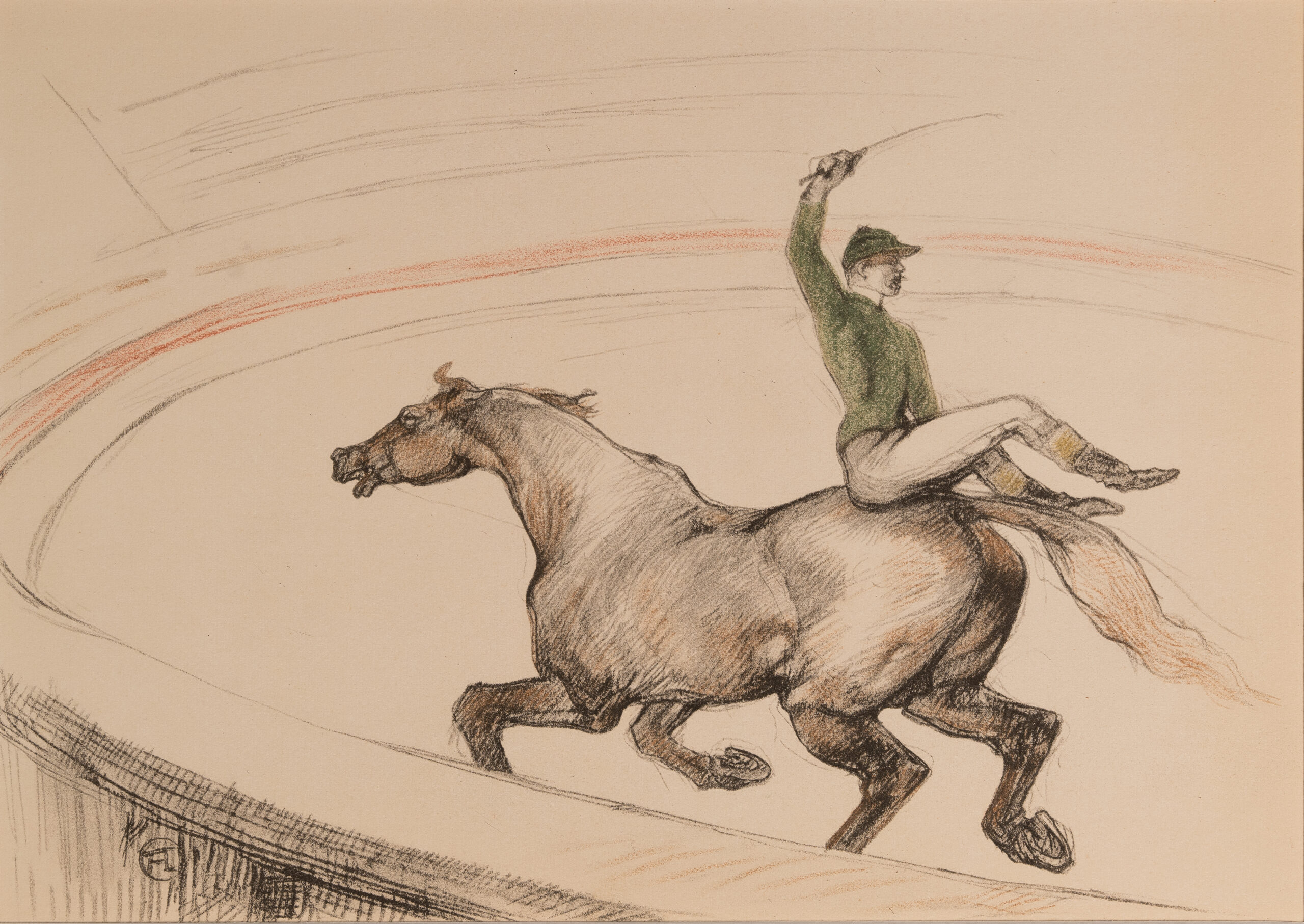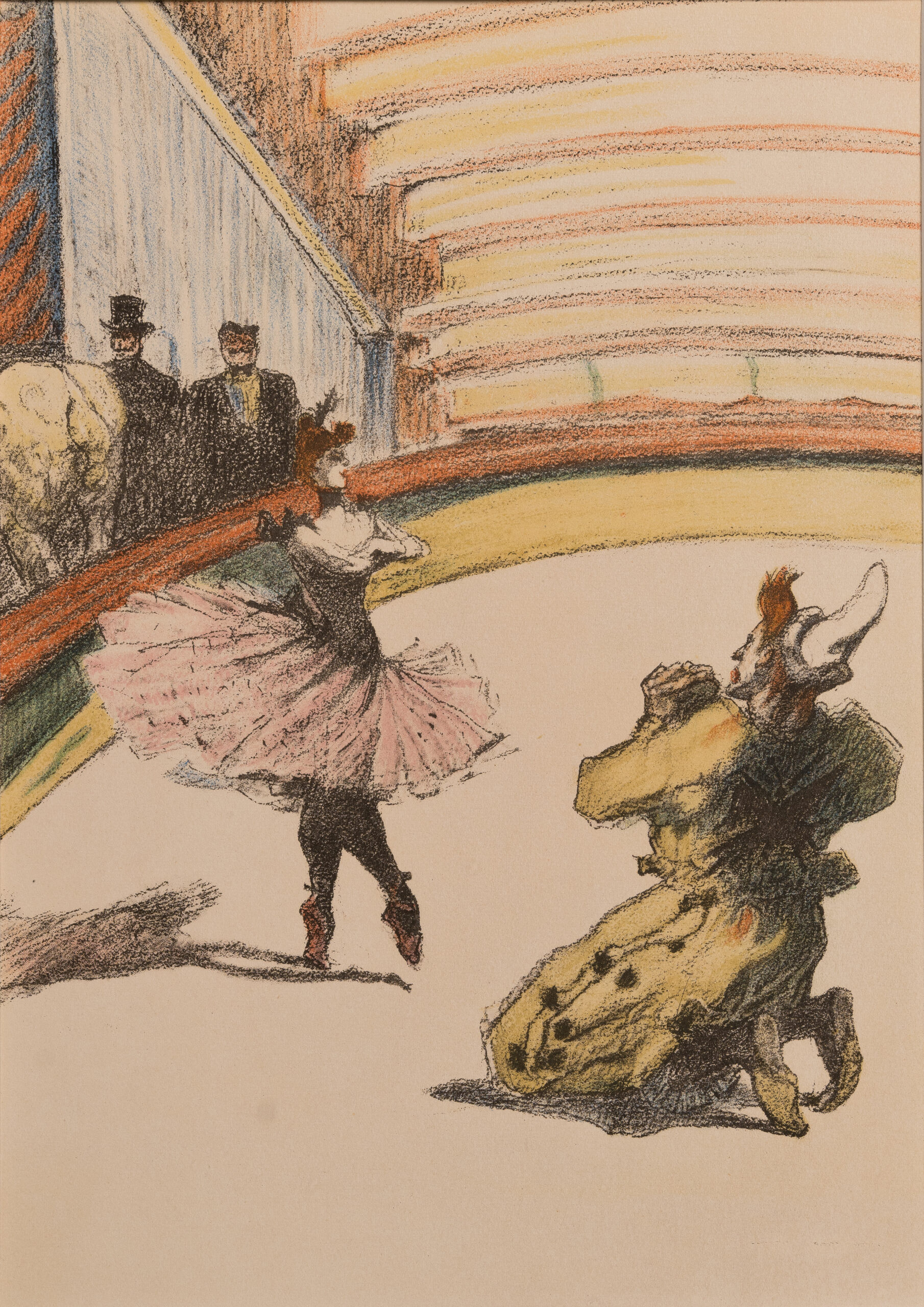
HENRI DE TOULOUSE-LAUTREC, Il Circo – Fantino. Litografia – Ed. 1905. Parigi (Francia). 19 x 27 cm (cc 38 x 48 cm)
Ci sono casi in cui un artista riesce ad influenzare la cultura anche dopo la sua morte. È capitato a Vincent van Gogh, divenuto celebre dopo la morte, ma è accaduto anche a Henri de Toulouse-Lautrec, figura emblematica della Belle Époque, che ha lasciato un’eredità artistica impressionante nonostante la sua breve carriera.
Celebre per le opere in cui descrive la vita notturna di Parigi, Toulouse-Lautrec ha realizzato oltre circa 737 dipinti, oltre 4.748 disegni, una cifra vicina ai 270 acquarelli e ha prodotto anche numerose stampe e manifesti pubblicitari, sperimentando continuamente nuove forme e tecniche. La sua passione per l’arte grafica, specialmente per i manifesti e le stampe litografiche, ha segnato profondamente il settore della pubblicità, dimostrando che l’arte può essere tanto un mezzo di comunicazione quanto una forma di espressione personale.
Le opere postume di Toulouse-Lautrec

HENRI DE TOULOUSE-LAUTREC, Il Circo – Elefante in libertà. Litografia – Ed. 1905. Parigi (Francia). 24 x 17,5 cm (cc 48 x 38 cm)
Toulouse-Lautrec visse durante un’epoca di straordinarie rivoluzioni tecnologiche, in cui l’uso delle tecniche di stampa e della fotografia stavano diventando sempre più importanti per un artista. Questi cambiamenti non solo influenzarono il suo stile, ma amplificarono anche il suo interesse per la litografia a colori, una novità che sfruttò per realizzare alcune delle sue opere più conosciute.
Per Toulouse-Lautrec creare un manifesto o la copertina di un programma teatrale era un impegno serio quanto dipingere un quadro. Una visione che trasformò profondamente il ruolo dell’artista nell’era moderna.
LA FAMA POSTUMA DI TOULOUSE-LAUTREC
Nonostante la sua genialità, la fama di Toulouse-Lautrec si consolidò principalmente dopo la sua morte, grazie agli sforzi del suo amico Maurice Joyant.
Joyant non solo organizzò le prime mostre postume delle opere di Toulouse-Lautrec, ma contribuì significativamente a costruire il mito dell’artista, persuadendo la madre a donare molte delle sue creazioni al Musée Toulouse-Lautrec ad Albi. La collaborazione con l’importante mercante d’arte Adolphe Goupil, inoltre, fu cruciale per la diffusione delle sue opere, rendendole accessibili a un pubblico sempre più vasto.
LE OPERE POSTUME
Uno degli esempi più toccanti dell’eredità lasciata da Toulouse-Lautrec è la serie “Au Cirque”, una collezione di 39 disegni creati durante il suo soggiorno in un sanatorio nel 1899.
Questi lavori, che catturano con intensità e sensibilità scene di vita circense, furono pubblicati postumi da Joyant nel 1905 e hanno continuato a suscitare ammirazione e interesse. La seconda edizione di quest araccolta, completata nel 1931, ha permesso a queste opere di raggiungere un pubblico ancora più ampio, consolidando ulteriormente il legame tra Toulouse-Lautrec e l’arte della Belle Époque.

HENRI DE TOULOUSE-LAUTREC, Il Circo –La resa. Litografia – Ed. 1905. Parigi (Francia). 25,5 x 18 cm (cc 48 x 38 cm)
L’opera di Toulouse-Lautrec è caratterizzata da un’impronta personale e innovativa, tuttavia rimane anche una testimonianza di un’epoca e di un artista che ha saputo trasformare ogni sfida personale e professionale in un’opportunità per rinnovare la sua arte, influenzando la storia della grafica e della pittura.

